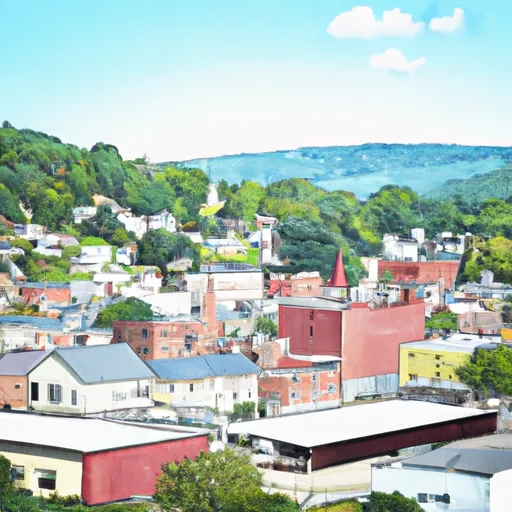-
 Snoflo Premium
Snoflo Premium
Get unlimited access to all our content
With no Ad interruptions! - Start Your Free Trial Login with existing account
Thompsontown
Eden Index
Climate
8.2
•
Recreation
2.8
•
Community
•
Safeguard
4.3/10

Thompsontown is a small borough located in Juniata County, Pennsylvania. The climate in Thompsontown is classified as humid continental, with warm summers and cold winters. Average temperatures range from 25°F (-4°C) in winter to 85°F (29°C) in summer. Precipitation is evenly distributed throughout the year, with an average of 45 inches of rainfall annually.
The town is situated near the Juniata River, which provides opportunities for various outdoor activities. Fishing enthusiasts can enjoy angling for smallmouth bass, catfish, and trout in the river. Additionally, there are several nearby streams and creeks that offer additional fishing opportunities.
Outdoor recreation opportunities in Thompsontown extend beyond fishing. The region is known for its scenic beauty, making it an excellent destination for hiking, camping, and nature exploration. Juniata County is home to several state parks, such as Tuscarora State Forest and Little Buffalo State Park, offering opportunities for hiking, picnicking, and wildlife viewing.
In summary, Thompsontown, Pennsylvania, offers a pleasant climate with distinct seasons, ample precipitation, and access to the Juniata River, making it an ideal location for outdoor enthusiasts, particularly those interested in fishing, hiking, and camping.
What is the Eden Index?
The Snoflo Eden Index serves as a comprehensive rating system for regions, evaluating their desirability through a holistic assessment of climate health, outdoor recreation opportunities, and natural disaster risk, acknowledging the profound impact of these factors on livability and well-being.
Climate Health Indicator (CHI): 8.2
Thompsontown receives approximately
1099mm of rain per year,
with humidity levels near 81%
and air temperatures averaging around
11°C.
Thompsontown has a plant hardyness factor of
6, meaning
plants and agriculture in this region thrive during a short period during spring and early summer. Most
plants will die off during the colder winter months.
By considering the ideal temperature range, reliable water supplies, clean air, and stable seasonal rain or snowpacks, the Climate Health Indicator (CHI) underscores the significance of a healthy climate as the foundation for quality living.
A healthy climate is paramount for ensuring a high quality of life and livability in a region, fostering both physical well-being and environmental harmony. This can be characterized by ideal temperatures, reliable access to water supplies, clean air, and consistent seasonal rain or snowpacks.
Weather Forecast
Streamflow Conditions
Lower Susquehanna
Area Rivers
Lower Susquehanna
Snowpack Depths
Lower Susquehanna
Reservoir Storage Capacity
Lower Susquehanna
Groundwater Levels
Recreational Opportunity Index (ROI): 2.8
The Recreational Opportunity Index (ROI) recognizes the value of outdoor recreational options, such as parks, hiking trails, camping sites, and fishing spots, while acknowledging that climate plays a pivotal role in ensuring the comfort and consistency of these experiences.
Access to outdoor recreational opportunities, encompassing activities such as parks, hiking, camping, and fishing, is crucial for overall well-being, and the climate plays a pivotal role in enabling and enhancing these experiences, ensuring that individuals can engage in nature-based activities comfortably and consistently.
Camping Areas
| Campground | Campsites | Reservations | Toilets | Showers | Elevation |
|---|---|---|---|---|---|
| Pine Grove Furnace State Park | None | 808 ft | |||
| Little Pine State Park | None | 703 ft | |||
| Ravensburg State Park | 21 | 1,033 ft | |||
| RB Winter State Park | None | 1,524 ft |
Nearby Fishing
Nearby Ski Areas
Catastrophe Safeguard Index (CSI):
The Catastrophe Safeguard Index (CSI) recognizes that natural disaster risk, encompassing floods, fires, hurricanes, and tornadoes, can drastically affect safety and the overall appeal of an area.
The level of natural disaster risk in a region significantly affects safety and the overall livability, with climate change amplifying these risks by potentially increasing the frequency and intensity of events like floods, fires, hurricanes, and tornadoes, thereby posing substantial challenges to community resilience and well-being.
Community Resilience Indicator (CRI):
The Community Resilience Indicator (CRI) recognizes that education, healthcare, and socioeconomics are crucial to the well-being of a region. The CRI acknowledges the profound impact of these elements on residents' overall quality of life. By evaluating educational resources, healthcare accessibility, and economic inclusivity, the index captures the essential aspects that contribute to a thriving community, fostering resident satisfaction, equity, and social cohesion.

